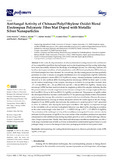Mostrar el registro sencillo del ítem
Antifungal activity of chitosan/poly (ethylene oxide) blend electrospun polymeric fiber mat doped with metallic silver nanoparticles
| dc.creator | Murillo Larrey, Leire | es_ES |
| dc.creator | Rivero Fuente, Pedro J. | es_ES |
| dc.creator | Sandúa Fernández, Xabier | es_ES |
| dc.creator | Pérez Garrido, Gumersinda | es_ES |
| dc.creator | Palacio, José F. | es_ES |
| dc.creator | Rodríguez Trías, Rafael | es_ES |
| dc.date.accessioned | 2024-01-31T17:34:06Z | |
| dc.date.available | 2024-01-31T17:34:06Z | |
| dc.date.issued | 2023 | |
| dc.identifier.citation | Murillo, L., Rivero, P. J., Sandúa, X., Pérez, G., Palacio, J. F., Rodríguez, R. J. (2023) Antifungal activity of chitosan/poly(ethylene oxide) blend electrospun polymeric fiber mat doped with metallic silver nanoparticles. Polymers, 15(18), 1-18. https://doi.org/10.3390/polym15183700. | en |
| dc.identifier.issn | 2073-4360 | |
| dc.identifier.uri | https://hdl.handle.net/2454/47307 | |
| dc.description.abstract | In this work, the implementation of advanced functional coatings based on the combination of two compatible nanofabrication techniques such as electrospinning and dip-coating technology have been successfully obtained for the design of antifungal surfaces. In a first step, uniform and beadless electrospun nanofibers of both polyethylene oxide (PEO) and polyethylene (PEO)/chitosan (CS) blend samples have been obtained. In a second step, the dip-coating process has been gradually performed in order to ensure an adequate distribution of silver nanoparticles (AgNPs) within the electrospun polymeric matrix (PEO/CS/AgNPs) by using a chemical reduction synthetic process, denoted as in situ synthesis (ISS). Scanning electron microscopy (SEM) has been used to evaluate the surface morphology of the samples, showing an evolution in average fiber diameter from 157 ± 43 nm (PEO), 124 ± 36 nm (PEO/CS) and 330 ± 106 nm (PEO/CS/AgNPs). Atomic force microscopy (AFM) has been used to evaluate the roughness profile of the samples, indicating that the ISS process induced a smooth roughness surface because a change in the average roughness Ra from 84.5 nm (PEO/CS) up to 38.9 nm (PEO/CS/AgNPs) was observed. The presence of AgNPs within the electrospun fiber mat has been corroborated by UV-Vis spectroscopy thanks to their characteristic optical properties (orange film coloration) associated to the Localized Surface Plasmon Resonance (LSPR) phenomenon by showing an intense absorption band in the visible region at 436 nm. Energy dispersive X-ray (EDX) profile also indicates the existence of a peak located at 3 keV associated to silver. In addition, after doping the electrospun nanofibers with AgNPs, an important change in the wettability with an intrinsic hydrophobic behavior was observed by showing an evolution in the water contact angle value from 23.4° ± 1.3 (PEO/CS) up to 97.7° ± 5.3 (PEO/CS/AgNPs). The evaluation of the antifungal activity of the nanofibrous mats against Pleurotus ostreatus clearly indicates that the presence of AgNPs in the outer surface of the nanofibers produced an important enhancement in the inhibition zone during mycelium growth as well as a better antifungal efficacy after a longer exposure time. Finally, these fabricated electrospun nanofibrous membranes can offer a wide range of potential uses in fields as diverse as biomedicine (antimicrobial against human or plant pathogen fungi) or even in the design of innovative packaging materials for food preservation. | en |
| dc.format.mimetype | application/pdf | en |
| dc.language.iso | eng | en |
| dc.publisher | MDPI | en |
| dc.relation.ispartof | Polymers 2023, 15(18), 3700 | en |
| dc.rights | © 2023 by the authors. Licensee MDPI, Basel, Switzerland. This article is an open access article distributed under the terms and conditions of the Creative Commons Attribution (CC BY) license. | en |
| dc.rights.uri | http://creativecommons.org/licenses/by/4.0/ | |
| dc.subject | Electrospinning | en |
| dc.subject | Dip-coating | en |
| dc.subject | Blend electrospun mat | en |
| dc.subject | Chitosan | en |
| dc.subject | Polyethylene oxide | en |
| dc.subject | LSPR | en |
| dc.subject | AgNPs | en |
| dc.subject | Antifungal | en |
| dc.title | Antifungal activity of chitosan/poly (ethylene oxide) blend electrospun polymeric fiber mat doped with metallic silver nanoparticles | en |
| dc.type | Artículo / Artikulua | es |
| dc.type | info:eu-repo/semantics/article | en |
| dc.date.updated | 2024-01-31T17:05:28Z | |
| dc.contributor.department | Ingeniería | es_ES |
| dc.contributor.department | Ingeniaritza | eu |
| dc.contributor.department | Institute for Multidisciplinary Research in Applied Biology - IMAB | en |
| dc.contributor.department | Institute for Advanced Materials and Mathematics - INAMAT2 | en |
| dc.rights.accessRights | Acceso abierto / Sarbide irekia | es |
| dc.rights.accessRights | info:eu-repo/semantics/openAccess | en |
| dc.identifier.doi | 10.3390/polym15183700 | |
| dc.relation.publisherversion | https://doi.org/10.3390/polym15183700 | |
| dc.type.version | Versión publicada / Argitaratu den bertsioa | es |
| dc.type.version | info:eu-repo/semantics/publishedVersion | en |



